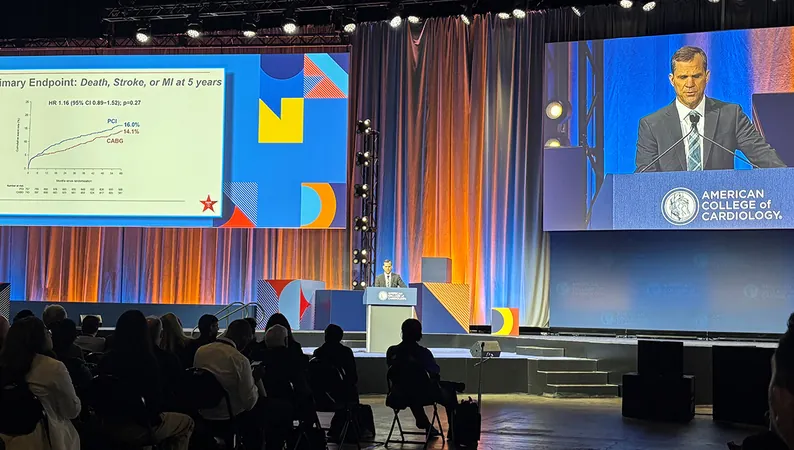
Groundbreaking FAME 3 Trial Results: PCI Outcomes Match CABG After 5 Years!
2025-03-31
Author: Olivia
CHICAGO, IL — In a major breakthrough for cardiac care, the final follow-up data from the FAME 3 trial reveals that five years post-treatment, patients suffering from three-vessel coronary artery disease who underwent Fractional Flow Reserve (FFR)-guided Percutaneous Coronary Intervention (PCI) experience clinical outcomes comparable to those who initially received Coronary Artery Bypass Grafting (CABG). This pivotal finding was presented at the 2025 American College of Cardiology (ACC) Scientific Session.
The trial followed 1,500 patients who were randomly assigned to either FFR-guided PCI—where lesions with a flow reserve of ≤0.80 were treated with stents—or CABG based on angiographic analysis. At the five-year mark, a staggering 96% of patients who underwent PCI and 94% of CABG patients completed the study, demonstrating rigorous adherence to medical therapy.
The results are a striking contrast to the initial findings of FAME 3, which indicated that PCI did not achieve noninferiority compared to CABG in terms of composite outcomes of death, stroke, myocardial infarction (MI), or repeat revascularization in the first year. However, by year three, trends suggested no significant differences in these outcomes between the two approaches.
Lead investigator Dr. William F. Fearon from Stanford University emphasized that these new findings reflect substantial advancements in both surgical and non-surgical techniques, "Outcomes improve as we incorporate contemporary strategies in both PCI and CABG, highlighting an evolution in how we care for patients with this type of coronary artery disease."
Dr. Akshay Khandelwal of Allegheny Health Network noted these findings mark a significant moment in cardiovascular medicine, "With the right physiological data guiding treatment, PCI has shown it can come close to the outcomes achieved with traditional CABG. This warrants important discussions among healthcare teams when strategizing patient care."
Noteworthy Data and Observations
The data revealed that while there were no significant differences in the composite outcome of death, stroke, or MI between the two groups at five years, the PCI group experienced higher rates of MI and repeat revascularization. A deeper analysis highlighted that for patients with low SYNTAX scores (less than 23), outcomes were favorable regardless of treatment type. Meanwhile, those with intermediate SYNTAX scores actually fared worse with PCI, highlighting the necessity of personalized patient management.
Interestingly, Dr. Fearon contrasted FAME 3's results with the 2009 SYNTAX trial, noting improved outcomes for PCI at five years, a testament to advancements in stent technology and adherence to evidence-based medical therapies. The FAME 3 findings further suggest a paradigm shift in decision-making between patients and providers, as growing data indicate that the outcomes of PCI can rival those of CABG in select populations.
Exploring Future Potentials
Dr. Fearon also spoke about the expanding role of coronary physiology in modern interventional cardiology. While FFR remains vital, additional methodologies, like indices for microcirculatory resistance, are gaining traction in understanding complex cardiac ailments. With continued research, non-invasive techniques derived from advanced imaging strategies are poised to transform patient assessments.
A Surgeon’s Insight
S. Chris Malaisrie, MD from Northwestern University reflected on the implications of the trial, pondering the potential role of FFR in guiding CABG procedures. He questioned whether this technique, which has shown to reduce the number of stents used in PCI, could be beneficial in a surgical context as well.
Conclusion
The FAME 3 trial results are a landmark step in the ongoing discourse on the best treatment approaches for patients with multivessel coronary artery disease. As medical technology and treatment protocols continue to evolve, these findings underscore the critical need for shared decision-making in cardiac care, ensuring that patients receive the best individualized treatment options available.
Get ready for the future of cardiac care where minimally invasive treatments hold the potential to rival traditional surgical techniques, making heart health more accessible and effective than ever!









 Brasil (PT)
Brasil (PT)
 Canada (EN)
Canada (EN)
 Chile (ES)
Chile (ES)
 Česko (CS)
Česko (CS)
 대한민국 (KO)
대한민국 (KO)
 España (ES)
España (ES)
 France (FR)
France (FR)
 Hong Kong (EN)
Hong Kong (EN)
 Italia (IT)
Italia (IT)
 日本 (JA)
日本 (JA)
 Magyarország (HU)
Magyarország (HU)
 Norge (NO)
Norge (NO)
 Polska (PL)
Polska (PL)
 Schweiz (DE)
Schweiz (DE)
 Singapore (EN)
Singapore (EN)
 Sverige (SV)
Sverige (SV)
 Suomi (FI)
Suomi (FI)
 Türkiye (TR)
Türkiye (TR)
 الإمارات العربية المتحدة (AR)
الإمارات العربية المتحدة (AR)